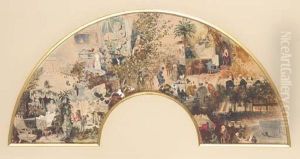Leon-Gabriel Coffinieres De Nordeck Paintings
Leon-Gabriel Coffinieres de Nordeck, born in 1836 and passing away in 1909, was a French artist whose work spanned the latter half of the 19th century and the early years of the 20th century. Not as widely recognized as some of his contemporaries, Coffinieres de Nordeck nonetheless contributed to the artistic landscape of his time, primarily working within the realms of painting and drawing. His artistic output is characterized by its diversity, encompassing a variety of subjects from landscapes and seascapes to more intimate portraits and genre scenes.
Coffinieres de Nordeck was born into an era of great transformation in the art world. The mid-19th century was a period marked by the struggle between traditional academic art and the emerging movements that sought to challenge the status quo, such as Realism and, later, Impressionism. While there is limited detailed information about his training and early career, it is known that he was active during a time when artists were beginning to explore new techniques, subjects, and ways of seeing. This context of change and experimentation likely influenced Coffinieres de Nordeck’s own development as an artist.
Despite the scant documentation of his life, Coffinieres de Nordeck’s surviving works suggest that he was adept at capturing the nuances of light and atmosphere, a hallmark of the Impressionist movement, though he did not strictly adhere to any single artistic movement. His landscapes and seascapes, in particular, demonstrate a keen eye for detail and a sensitive handling of color, suggesting a deep appreciation of nature’s beauty. Moreover, his portraits and genre scenes reveal an interest in the daily lives and emotions of his subjects, imbuing his work with a sense of intimacy and immediacy.
Coffinieres de Nordeck’s contribution to art, while perhaps not as celebrated as that of some of his peers, offers a glimpse into the rich tapestry of 19th-century French art. His works provide valuable insights into the transitional period of art history in which he lived, reflecting the shifting tastes and aesthetic values of his time. Though more research may be needed to fully appreciate the extent of his impact, the existing body of his work continues to be appreciated by art historians and collectors alike for its beauty and historical significance.
